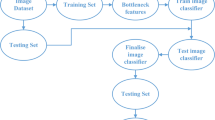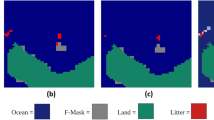Abstract
Estimating the volume of macro-plastics which dot the world’s oceans is one of the most pressing environmental concerns of our time. Prevailing methods for determining the amount of floating plastic debris, usually conducted manually, are time demanding and rather limited in coverage. With the aid of deep learning, herein, we propose a fast, scalable, and potentially cost-effective method for automatically identifying floating marine plastics. When trained on three categories of plastic marine litter, that is, bottles, buckets, and straws, the classifier was able to successfully recognize the preceding floating objects at a success rate of ≈ 86%. Apparently, the high level of accuracy and efficiency of the developed machine learning tool constitutes a leap towards unraveling the true scale of floating plastics.









Similar content being viewed by others
References
Barnes DKA, Galgani F, Thompson RC, Barlaz M (2009) Accumulation and fragmentation of plastic debris in global environments. Philos Trans R Soc Lond B Biol Sci 364:1985–1998
Chambault P, Vandeperre F, Machete M, Lagoa JC, Pham CK (2018) Distribution and composition of floating macro litter off the Azores archipelago and Madeira (NE Atlantic) using opportunistic surveys. Mar Environ Res 141:225–232
Cózar A, Echevarría F, González-Gordillo JI, Irigoien X, Úbeda B, Hernández-León S, Palma ÁT, Navarro S, García-de-Lomas J, Ruiz A, Fernández-de-Puelles ML, Duarte CM (2014) Plastic debris in the open ocean. Proc Natl Acad Sci 111:10239–10244
Deidun A, Gauci A, Lagorio S, Galgani F (2018) Optimising beached litter monitoring protocols through aerial imagery. Mar Pollut Bull 131:212–217
Eriksen M, Lebreton LCM, Carson HS, Thiel M, Moore CJ, Borerro JC, Galgani F, Ryan PG, Reisser J (2014) Plastic pollution in the world’s oceans: more than 5 trillion plastic pieces weighing over 250,000 tons afloat at sea. PLoS ONE 9:1–15
González-Fernández D, Hanke G (2017) Toward a harmonized approach for monitoring of riverine floating macro litter inputs to the marine environment. Front Mar Sci 4
Hastie TJ, Tibshirani RJ, Friedman JH (2013) The elements of statistical learning: data mining, inference, and prediction. Springer, New York
Hengstmann E, Gräwe D, Tamminga M, Fischer EK (2017) Marine litter abundance and distribution on beaches on the Isle of Rügen considering the influence of exposition, morphology and recreational activities. Mar Pollut Bull 115:297–306
Kylili K, Artusi A, Kyriakides I, Hadjistassou C (2018) Tracking and identifying floating marine debris, 6th International Marine Debris Conference, San Diego, California, US
Lebreton L, Slat B, Ferrari F, Sainte-Rose B, Aitken J, Marthouse R, Hajbane S, Cunsolo S, Schwarz A, Levivier A, Noble K, Debeljak P, Maral H, Schoeneich-Argent R, Brambini R, Reisser J (2018) Evidence that the Great Pacific Garbage Patch is rapidly accumulating plastic. Sci Rep 8:4666
LeCun, Y., Boser, B., Denker, J.S., Henderson, D., Howard, R.E., Hubbard, W., Jackel, L.D., 1989. Handwritten digit recognition with a back-propagation network, Proceedings of the 2nd International Conference on Neural Information Processing Systems. MIT Press, pp. 396–404
LeCun Y, Bottou L, Bengio Y, Haffner P (1998) Gradient-based learning applied to document recognition. Proc IEEE 86:2278–2324
LeCun Y, Bengio Y, Hinton G (2015) Deep learning. Nature 521:436–444
Moy K, Neilson B, Chung A, Meadows A, Castrence M, Ambagis S, Davidson K (2018) Mapping coastal marine debris using aerial imagery and spatial analysis. Mar Pollut Bull 132:52–59
MSFD Technical Subgroup on Marine Litter (2013) Guidance on monitoring of marine litter in European seas. JRC83985, Joint Research Centre Scientific and Policy Reports, Luxembourg
Pan SJ, Yang Q (2010) A survey on transfer learning. IEEE Trans Knowl Data Eng 22:1345–1359
Simonyan K, Zisserman A (2014) Very deep convolutional networks for large-scale image recognition. ICLR 2015
Suaria G, Aliani S (2014) Floating debris in the Mediterranean Sea. Mar Pollut Bull 86:494–504
Sun, C., Shrivastava, A., Singh, S., Gupta, A., 2017. Revisiting Unreasonable Effectiveness of Data in Deep Learning Era, 2017 IEEE International Conference on Computer Vision (ICCV), pp. 843–852
Wang Y, Wang D, Lu Q, Luo D, Fang W (2015) Aquatic debris detection using embedded camera sensors. Sensors 15:3116–3137
Woodall LC, Sanchez-Vidal A, Canals M, Paterson GLJ, Coppock R, Sleight V, Calafat A, Rogers AD, Narayanaswamy BE, Thompson RC (2014) The deep sea is a major sink for microplastic debris. R Soc Open Sci 1
Funding
K. K. acknowledges financial support from the Universitas Foundation, the A. G. Leventis Foundation, and the University of Nicosia. A. A.’s work is financially supported by the European Union’s Horizon 2020 research and innovation program under grant agreement No 739551 (KIOS CoE) and from the Government of the Republic of Cyprus through the Directorate General for European Programmes, Coordination and Development.
Author information
Authors and Affiliations
Corresponding author
Additional information
Responsible editor: Philippe Garrigues
Publisher’s note
Springer Nature remains neutral with regard to jurisdictional claims in published maps and institutional affiliations.
Rights and permissions
About this article
Cite this article
Kylili, K., Kyriakides, I., Artusi, A. et al. Identifying floating plastic marine debris using a deep learning approach. Environ Sci Pollut Res 26, 17091–17099 (2019). https://doi.org/10.1007/s11356-019-05148-4
Received:
Accepted:
Published:
Issue Date:
DOI: https://doi.org/10.1007/s11356-019-05148-4




